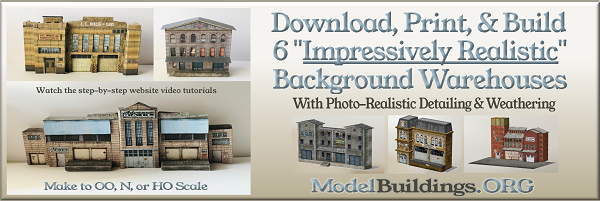Everything on model trains, model railroads, model railways, locomotives, model train layouts, scenery, wiring, DCC and more. Enjoy the world's best hobby... model railroading!
What’s The Correct Way To Do Railroad Wiring?
Anthony G asks readers:
“I am confused with what wire to use for wiring my track… I will run DCC. Should I use a different gauge for switches, signals, inside structures? What about color coding? I read something about telephone wire – that confused me more. Do I need a different gauge for 12 volt power supply and a different gauge to the track? Any safety issues to watch out for? Can people help coz it’s hard for me to get my head around all this stuff? A lot for me to learn.”
11 Responses to What’s The Correct Way To Do Railroad Wiring?
Leave a Reply
















When you are wiring your layout it is important to use the same color wire for the same item being wired.
That means I.E. Use red/ black for track buss wiring.
Use a different color wire I.E. (yellow /green) for powering switch machines =turnouts
Use a different color wire I.E. (blue/ orange) for lighting buildings.
This is real important when you are under the layout trying to trouble shoot a problem.
When you look up at the underside of the table you will see different colors of wire and
know what you are looking for based on the color of that devise.
As far as the size of the wire I.E. 14 gauge 12 gauge 22 gauge etc that depends on the length of the run to that devise. The longer the distance the heavier the size of the wire.
I hope you are not confused and understand this.
donj1044 has set you off on the right track, but see how he writes “red/black” or blue/orange”? I know this might be clear as crystal to people involved with electrical stuff, but lots of people know beans about ‘tricity. Electricity works by pumping energy into one side of a device, where it winds its way through all the gubbins (resistors, capacitors, motors etc.) to make it do its thing, and out the other side so it can return to whence it came In a word, it only works in an enclosed loop.
And so, as model railway builders, in order to have this in/out effect we connect a red wire to one track, and a black wire to the other. When power is applied the energy runs up one track, through the motor and back down the other. With DCC its a little bit more involved, but that is the basic scenario.
That brings us back to previous posts where we pointed out that ,as the builder, you need to decide which is the in and which is the out track, which we conventionally call N (North) and S (South) or + and -. To wire your layout for DCC connect a red dropper wire to one rail in each section of rail, and black on the other. This then dangles under the roadbed. Now run a heavier bus wire (some of us use house wiring with the outer insulation removed) and connect all the red droppers to the red bus and the black droppers to the other. So long as you haven’t mucked up your + and – rails to cause a short circuit, your trains should run.
I know this is a simplified version of what is a black art growing in complexity daily but if one starts here then the future will be rosy. Sorry if I offend all the wonderful boffins out there who find my explanation condescending, but we’re not all electronics experts.
Have fun.
Brilliant reply, we are not all boffins has you say and the colour explanation was spot on. I am just about to embark on DCC and I am finding it all so confusing, but I will preserver because I want to buy a Roco Z21 Black command unit.
Rod 🙂
Very good replies so far. If you’re a little overwhelmed just remember ;
You’re making very simple circuits, you’re just doing it over and over again.
The larger and more complex your layout is then the more complex your wiring will look.
Make a circuit diagram as you go, it will be invaluable if you get an electrical problem later.
The only amendment I would make to the above is Point motors (switch/turnout motors) need three wires, not two, so you will need three colours for those. These motors also draw more current than you would think so use heavier gauge wire for these. I also struggled with wiring these in the beginning, so I made a testbed.
Take a turnout, a motor, a switch, an appropriate power supply (normally 16v AC), and a Capacitor Discharge Unit. Fit the turnout and switch to the lid of a shoebox and then wire up as if it were on a board. If you need to, search for a tutorial (there are plenty on the internet). Once I had this up and running it was much easier to understand because I was looking at a completely isolated circuit – no track or lighting wiring to confuse the issue. It can be useful to refer back to this when you’re wiring the actual layout as well. Remember, simple circuits repeated many times over.
When I was building my layout I went round garage/boot sales looking for extension cords. It’s amazing how many people break their lawnmower/strimmer but keep the extension cord. Because they normally have a proprietary plug/socket on the end, nobody is interested in buying them, which makes them cheap. Cut the plug/socket off and you now have 20-30mtrs of heavy gauge wire. Just cut to length and strip the ends.
Hope this helps.
Mark J
David Stokes reply to this topic has a number of ambiguities in it. .Just about every time he uses the word “track” he is referring to one rail, not a whole piece of track. In paragraph 2 he writes “we connect a red wire to one track, and a black wire to the other.” What he means is we connect a red wire to one RAIL, and a black wire to the other RAIL of the track.so that when power is applied the energy runs up one RAIL, through the motor and back down the other RAIL.
In the next paragraph he refers to the deciding which is the in and out track. He means decide which is the feed rail and which is the return rail.
Have fun and take your time. Concentrate on adding one wire at a time and keep to your chosen colour code for the whole wiring system.
Great stuff from the guys above..I actually found when I converted to DCC that the wiring was easier and a lot less of it..My only advise is to start with your simple circuit (of rails) and get it wired and running..Then anything you add after that if things dont work you know where to look..There are plenty of beginner “How to start with DCC.” books out there..Study and research before you start,it pays off,otherwise you will end up a frustrated ex railway modeller with a pile of rails in a cupboard..Happy Modelling ..
Working out what the thickness of a wire is depends on the current and load and very important the amount of voltage drop that is acceptable. This can become quite confusing to the “non” electrical guys.
To solve the problem I have written a train tool that can do it as I got very frustrated with wiring and wire thickness. It is available on vansoft.co.za under downloads and is called Model Railroad Scale Converter and Tools. It is absolutely free with no strings attached.
All you need to do is enter the current in the wire, the voltage applied and the length of the run. It will calculate the voltage drop over the distance for the selected wire gauge in volts and percent. There is also a couple of other useful tools. Included is a image of the tool.
Happy Wiring 🙂
What file can be used to open the scale converter installer?
To install the tool you need to download it by clicking on the link and then select save as. Once downloaded just run it to install.
The following tools are available:
1. Scale converter / calculator.
2. Incline calculator.
3. Helix design calculator
4. Scale speed calculator.
5. Wire thickness calculator
6. Electronics calculator (Mainly used to calculate resistor values for LED’s)
Image of the helix calculator
Does every piece of track need to have a wire on it??? Sounds a little redundant to me.
James No Basically I will have connections about 4 to 8 feet. In other words I will feed to a connection between two sections of flex track. So if you connect at a pair of flex track you should also get power through one without the wire connection. I do make sure I have power on each side of my switches as you can loose some power through several switches depending how they connect through the switch. If you have sections of layout like a club has using modules just make sure you use a power connection from each module so that the connecting section of track between the modules will have power from both sides of it so you should get power through it from at least one side. If you have the whole thing in sectional track you might want to connect in about every 3 feet to help keep from getting voltage drop. If you use buss wires underneath of 16 gauge at least, then your power will carry all the way and your wire drops to the rails can be phone wire. You don;t really have to solder right to the rail. I solder to the bottom of the connector but just don’t get it too hot. Get your soldiering iron off as soon as possible Using Flux helps.To do that I solder the wire tips and some on the bottom of the connectors Then I lay the wire end on the connector and hold my soldering iron on top of the wire and the connector and as soon as it melts together.
Either way your best wiring will be to run buss wires and then feed wire drops made of phone wire (only a foot or 2 will work fine). If your engines slow down the farther away you get from your power buss wires protect from that by giving you fresh and close power without loosing power from all your track connections. On a layout with a small loop of track (what ever your track choice) you should not see power drop. But the rule of thumb is the more connectors the more the chance of power drop from Newman